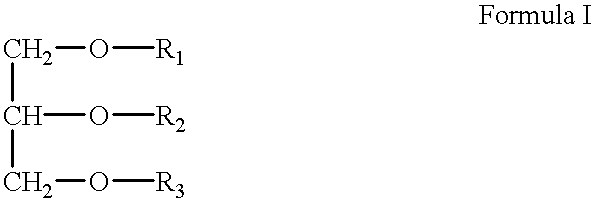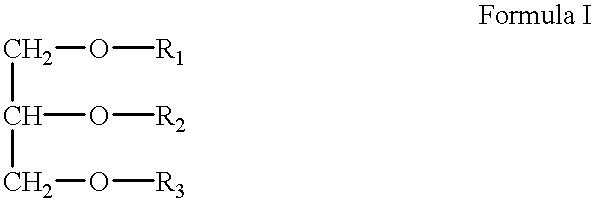Composition and method for early bloom thinning of fruit trees and controlling cracking of fruits
a technology fruit, applied in the field of composition and method of early bloom thinning of fruit trees, can solve the problems of inadequate thinning, foliage or fruit injury, russet on the early-developed fruit or injury to leaves, etc., and achieve the effect of effective thinning and minimizing the phytotoxicity of copper compounds
- Summary
- Abstract
- Description
- Claims
- Application Information
AI Technical Summary
Benefits of technology
Problems solved by technology
Method used
Image
Examples
example 1
[0069] Preparation of Emulsions with Glyceride Type of Lipids
[0070] Emulsion I was prepared by mixing 4 parts corn or soybean oil, 1 part monostearoyl-rac-glycerol, and 1 part TWEEN 60 by volume, heating the mixture to 90 degrees C., and adding 4 parts hot water (pre-heated to 90 degrees C) to the mixture with stirring. The water-in-oil emulsion thus formed was then left at room temperature for slow cooling. The emulsions thus prepared were then diluted with water to the application rate, 1%, 2.5%, and 5% of active ingredient. Both the mother emulsions and the diluted emulsions were used for stability evaluation.
[0071] Emulsion II was prepared by dissolving 0.3 grams of sodium hydroxide in 14 grams of glycerol and then adding 100 grams of commercial corn or soybean oil. With vigorous stirring, the mixture was heated to 200 degree C. for 1 hour. The reaction mixture was shown by thin layer chromatographic analysis to contain 22% triglycerides; 30% 1,3-diglycerides; 20% 1,2-diglycerid...
example 2
[0074] Glyceride Type of Lipids for Early Bloom Thinning on Pome and Stone Fruit Trees
[0075] Emulsions containing 4 parts corn or soybean oil, 1 part purified emulsifier, 1 part surfactant, and 4 parts water, by volume, were prepared as described in Example 1. Emulsions containing 1%, 2%, 3%, and 5% active ingredients and a water control were sprayed onto trees at 4 to 5% full bloom (FB). Each treatment consisted of 4 trees (replications) in a row (oriented from south to north) and 2 shoots (one from the east and another from the west side of the canopy) were selected from each of the 4 trees for evaluation. Fruit set was measured 2 months after FB. Leaf damage was evaluated 1, 2, and 3 weeks after application, and return bloom was evaluated the following season. Trees received standard commercial management both before and after oil application.
[0076] Emulsions made from corn oil or soybean oil showed similar efficacy, which increased as lipid concentration increased, and the linea...
example 3
[0077] Glyceride Type of Lipids for Early Bloom Thinning on Cherry Trees
[0078] Emulsions were prepared with glyceride type of lipids as described in Example 2. The experiment consisted of a randomized complete block design with 16 plots, which included all combinations of four lipid concentrations (1%, 3%, and 5% and water control) and four application times (bud break or popcorn, 20%, 50%, and 80% full bloom), in each of three blocks. Each treatment (plot) consisted of two rows with 4 trees in each row, which received standard commercial management both before and after oil application. In each treatment, 3 trees (replicates) were used and 6 shoots were selected from each tree for fruit set evaluation, which was presented as fruit number / 100 bloom clusters. Return bloom was evaluated the following season. Fruit weight, soluble solids, and total yields of cherries were measured at harvest. Fruit weight was measured using all fruit from the 6 shoots of each tree. Soluble solids conte...
PUM
 Login to View More
Login to View More Abstract
Description
Claims
Application Information
 Login to View More
Login to View More - R&D
- Intellectual Property
- Life Sciences
- Materials
- Tech Scout
- Unparalleled Data Quality
- Higher Quality Content
- 60% Fewer Hallucinations
Browse by: Latest US Patents, China's latest patents, Technical Efficacy Thesaurus, Application Domain, Technology Topic, Popular Technical Reports.
© 2025 PatSnap. All rights reserved.Legal|Privacy policy|Modern Slavery Act Transparency Statement|Sitemap|About US| Contact US: help@patsnap.com



